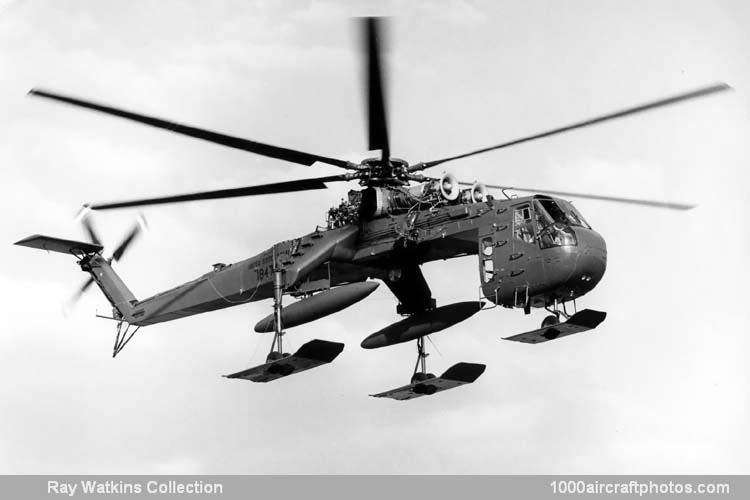11/30/2011. Remarks by Johan Visschedijk: "The S-64 Flying crane was designed initially for military transport duties. Equipped with interchangeable pods, it was suitable for use as a troop transport, and for minesweeping, cargo and missile transport, anti-submarine or field hospital operations. Equipment included a removable 25,000 lb (11,340 kg) hoist, a sling attachment and a load stabilizer to prevent undue sway in cargo winch operations. Attachment points were provided on the fuselage and landing gear to facilitate securing of bulky loads.
Under the designation S-64A the first of three prototypes flew for the first time on May 9, 1962 and was used by the US Army at Fort Benning, Georgia, for testing and demonstration. The second and third prototypes were delivered to Federal Germany for evaluation by the German armed forces. In June 1963, the US Army announced that it had ordered six S-64As, under the designation CH-54A, to investigate the heavy lift concept, with emphasis on increasing mobility in the battlefield.
Delivery of five CH-54As (originally YCH-54As) to the US Army took place in late 1964 and early 1965. A sixth CH-54A remained at Stratford, with a company-owned S-64, for a program leading toward a restricted FAA certification, which was awarded on July 30, 1965. Further US Army orders followed. The CH-54As were assigned to the US Army's 478th Aviation Company, and performed outstanding service in support of the Army's First Cavalry Division, Airmobile, in Vietnam.
On April 29, 1965, a CH-54A of the 478th Company lifted 90 persons, including 87 combat-equipped troops in a detachable van, by that time the largest number of people ever carried by a helicopter at one time. Other Skycranes transported bulldozers and road graders weighing up to 17,500lb (7,937 kg), 20,000 lb (9,072 kg) armored vehicles and a large variety of heavy hardware, and they retrieved more than 380 damaged aircraft.
Sikorsky Aircraft developed an all-purpose van, known as the Universal Military Pod, for carriage by the US Army's CH-54As, and received an order to supply 22 to the US Army. The pods were delivered complete with communications, ventilation and lighting systems, and with wheels to simplify ground handling. They superseded earlier pods which were not approved for the carriage of personnel.
With a max loaded weight of 20,000 lb (9,072 kg), each pod accommodates 45 combat-equipped troops, or 24 litters, and in the field may be adapted for a variety of uses, such as surgical unit, field command post and communications post. Internal dimensions of the pod were: length 27 ft; 5 in (8.36 m), width 8 ft 10 in (2.69 m) and height 6 ft 6 in (1.98 m). Doors were provided on each side of the forward area of the pod, and a double-paneled ramp was located aft. The first pod was accepted by the US Army on June 28, 1968, following approval for personnel transport.
On 15 February 1968, Sikorsky announced that it had received an order for two commercial Skycranes from Rowan Drilling Company, Inc, of Houston, Texas. These were delivered on April 18, 1969, for operation in support of oil exploration and drilling operations in Alaska.
FAA certification of the improved S-64E for civil use was announced in 1969, for the transportation of external cargo weighing up to 22,400lb (10,160 kg). In January 1972 Erickson Air-Crane Company of Marysville, California, purchased the first S-64E, for logging and other heavy-lift tasks. On November 1, 1972 this company ordered three additional S-64Es, the first of which was delivered in the following month.
Erickson intended to use this fleet of four aircraft to extend its operations on a worldwide basis, offering heavy-lift capability to the logging, petroleum, power line, shipping and general construction industries. Three S-64Es were operated by Evergreen Helicopters Inc of McMinnville, Oregon. One was ordered by Tri-Eagle Company in 1974, for timber harvesting in California.
On 4 November 1968 Sikorsky announced that it had received a US Army contract to increase the payload capacity of the CH-54 from
10 to 12.5 tons (9,072 to 11,340 kg). The contract called for a number of design improvements to the engine, gearbox, rotor head and structure; altitude performance and hot weather operating capability were also to be improved.
The original JFTD12-4A engines were replaced by two Pratt & Whitney JFTD12-5As, each rated at 4,800 shp, and a gearbox capable of receiving 7,900 hp from the two engines was introduced. Single-engine performance was increased, since the new gearbox receives 4,800 hp from one engine, compared with 4,050 hp on the CH-54A. A new rotor system was also introduced, utilizing a high-lift rotor blade with a chord some 2.5 in (6.35 cm) greater than that of the blades used formerly.
Other changes included the provision of dual wheels on the main landing gear, an improved automatic flight control system and some general structural strengthening throughout the aircraft. Gross weight was increased from 42,000 lb (19,050 kg) to 47,000 lb (21,318 kg). Two of the improved flying cranes, designated Model S-64F CH-54B, were accepted by the US Army during 1969. In October 1970, an US Army CH-54B lifted a 40,780 lb (18,497 kg) load during tests being conducted to evaluate maximum hover lift capability.
The commercial version S-64F received its FAA certification in late 1970. In late 1971-early 1972, the CH-54B set nine international helicopter records in Class E.l, for payload-to-height, time-to-height and altitude. A total of 105
S-64s have been produced, mostly for the US Army. After being struck off charge, a large number of the military CH-54s have been sold on the civil market and are still being used in the fire-fighting and logging industry.
The pictured aircraft was one of three CH-54Bs fitted with skis in 1971 for evaluation by the US Army in Alaska, two auxiliary tanks were also fitted. It was written off July 28, 1972."
